Jingyong Su
KAN or MLP? Point Cloud Shows the Way Forward
Apr 18, 2025Abstract:Multi-Layer Perceptrons (MLPs) have become one of the fundamental architectural component in point cloud analysis due to its effective feature learning mechanism. However, when processing complex geometric structures in point clouds, MLPs' fixed activation functions struggle to efficiently capture local geometric features, while suffering from poor parameter efficiency and high model redundancy. In this paper, we propose PointKAN, which applies Kolmogorov-Arnold Networks (KANs) to point cloud analysis tasks to investigate their efficacy in hierarchical feature representation. First, we introduce a Geometric Affine Module (GAM) to transform local features, improving the model's robustness to geometric variations. Next, in the Local Feature Processing (LFP), a parallel structure extracts both group-level features and global context, providing a rich representation of both fine details and overall structure. Finally, these features are combined and processed in the Global Feature Processing (GFP). By repeating these operations, the receptive field gradually expands, enabling the model to capture complete geometric information of the point cloud. To overcome the high parameter counts and computational inefficiency of standard KANs, we develop Efficient-KANs in the PointKAN-elite variant, which significantly reduces parameters while maintaining accuracy. Experimental results demonstrate that PointKAN outperforms PointMLP on benchmark datasets such as ModelNet40, ScanObjectNN, and ShapeNetPart, with particularly strong performance in Few-shot Learning task. Additionally, PointKAN achieves substantial reductions in parameter counts and computational complexity (FLOPs). This work highlights the potential of KANs-based architectures in 3D vision and opens new avenues for research in point cloud understanding.
Binarized Mamba-Transformer for Lightweight Quad Bayer HybridEVS Demosaicing
Mar 20, 2025Abstract:Quad Bayer demosaicing is the central challenge for enabling the widespread application of Hybrid Event-based Vision Sensors (HybridEVS). Although existing learning-based methods that leverage long-range dependency modeling have achieved promising results, their complexity severely limits deployment on mobile devices for real-world applications. To address these limitations, we propose a lightweight Mamba-based binary neural network designed for efficient and high-performing demosaicing of HybridEVS RAW images. First, to effectively capture both global and local dependencies, we introduce a hybrid Binarized Mamba-Transformer architecture that combines the strengths of the Mamba and Swin Transformer architectures. Next, to significantly reduce computational complexity, we propose a binarized Mamba (Bi-Mamba), which binarizes all projections while retaining the core Selective Scan in full precision. Bi-Mamba also incorporates additional global visual information to enhance global context and mitigate precision loss. We conduct quantitative and qualitative experiments to demonstrate the effectiveness of BMTNet in both performance and computational efficiency, providing a lightweight demosaicing solution suited for real-world edge devices. Our codes and models are available at https://github.com/Clausy9/BMTNet.
Typicalness-Aware Learning for Failure Detection
Nov 04, 2024



Abstract:Deep neural networks (DNNs) often suffer from the overconfidence issue, where incorrect predictions are made with high confidence scores, hindering the applications in critical systems. In this paper, we propose a novel approach called Typicalness-Aware Learning (TAL) to address this issue and improve failure detection performance. We observe that, with the cross-entropy loss, model predictions are optimized to align with the corresponding labels via increasing logit magnitude or refining logit direction. However, regarding atypical samples, the image content and their labels may exhibit disparities. This discrepancy can lead to overfitting on atypical samples, ultimately resulting in the overconfidence issue that we aim to address. To tackle the problem, we have devised a metric that quantifies the typicalness of each sample, enabling the dynamic adjustment of the logit magnitude during the training process. By allowing atypical samples to be adequately fitted while preserving reliable logit direction, the problem of overconfidence can be mitigated. TAL has been extensively evaluated on benchmark datasets, and the results demonstrate its superiority over existing failure detection methods. Specifically, TAL achieves a more than 5% improvement on CIFAR100 in terms of the Area Under the Risk-Coverage Curve (AURC) compared to the state-of-the-art. Code is available at https://github.com/liuyijungoon/TAL.
Skeleton-based Group Activity Recognition via Spatial-Temporal Panoramic Graph
Jul 28, 2024Abstract:Group Activity Recognition aims to understand collective activities from videos. Existing solutions primarily rely on the RGB modality, which encounters challenges such as background variations, occlusions, motion blurs, and significant computational overhead. Meanwhile, current keypoint-based methods offer a lightweight and informative representation of human motions but necessitate accurate individual annotations and specialized interaction reasoning modules. To address these limitations, we design a panoramic graph that incorporates multi-person skeletons and objects to encapsulate group activity, offering an effective alternative to RGB video. This panoramic graph enables Graph Convolutional Network (GCN) to unify intra-person, inter-person, and person-object interactive modeling through spatial-temporal graph convolutions. In practice, we develop a novel pipeline that extracts skeleton coordinates using pose estimation and tracking algorithms and employ Multi-person Panoramic GCN (MP-GCN) to predict group activities. Extensive experiments on Volleyball and NBA datasets demonstrate that the MP-GCN achieves state-of-the-art performance in both accuracy and efficiency. Notably, our method outperforms RGB-based approaches by using only estimated 2D keypoints as input. Code is available at https://github.com/mgiant/MP-GCN
Explore the Potential of CLIP for Training-Free Open Vocabulary Semantic Segmentation
Jul 11, 2024Abstract:CLIP, as a vision-language model, has significantly advanced Open-Vocabulary Semantic Segmentation (OVSS) with its zero-shot capabilities. Despite its success, its application to OVSS faces challenges due to its initial image-level alignment training, which affects its performance in tasks requiring detailed local context. Our study delves into the impact of CLIP's [CLS] token on patch feature correlations, revealing a dominance of "global" patches that hinders local feature discrimination. To overcome this, we propose CLIPtrase, a novel training-free semantic segmentation strategy that enhances local feature awareness through recalibrated self-correlation among patches. This approach demonstrates notable improvements in segmentation accuracy and the ability to maintain semantic coherence across objects.Experiments show that we are 22.3% ahead of CLIP on average on 9 segmentation benchmarks, outperforming existing state-of-the-art training-free methods.The code are made publicly available at: https://github.com/leaves162/CLIPtrase.
MIPI 2024 Challenge on Demosaic for HybridEVS Camera: Methods and Results
May 08, 2024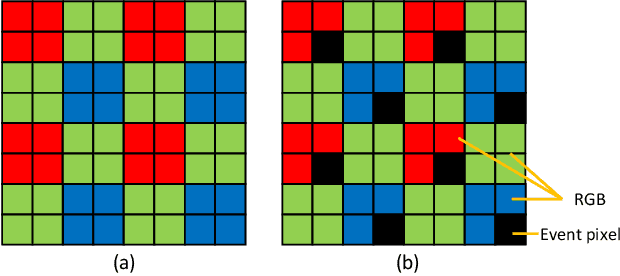
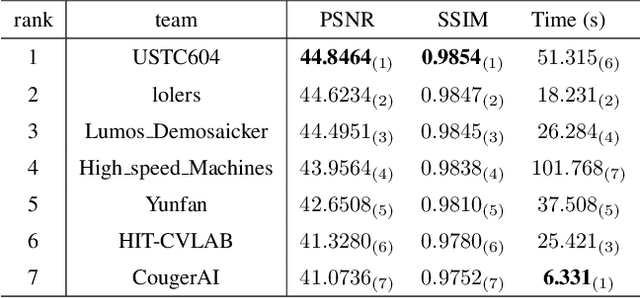


Abstract:The increasing demand for computational photography and imaging on mobile platforms has led to the widespread development and integration of advanced image sensors with novel algorithms in camera systems. However, the scarcity of high-quality data for research and the rare opportunity for in-depth exchange of views from industry and academia constrain the development of mobile intelligent photography and imaging (MIPI). Building on the achievements of the previous MIPI Workshops held at ECCV 2022 and CVPR 2023, we introduce our third MIPI challenge including three tracks focusing on novel image sensors and imaging algorithms. In this paper, we summarize and review the Nighttime Flare Removal track on MIPI 2024. In total, 170 participants were successfully registered, and 14 teams submitted results in the final testing phase. The developed solutions in this challenge achieved state-of-the-art performance on Nighttime Flare Removal. More details of this challenge and the link to the dataset can be found at https://mipi-challenge.org/MIPI2024/.
Hierarchical Dense Correlation Distillation for Few-Shot Segmentation-Extended Abstract
Jun 27, 2023



Abstract:Few-shot semantic segmentation (FSS) aims to form class-agnostic models segmenting unseen classes with only a handful of annotations. Previous methods limited to the semantic feature and prototype representation suffer from coarse segmentation granularity and train-set overfitting. In this work, we design Hierarchically Decoupled Matching Network (HDMNet) mining pixel-level support correlation based on the transformer architecture. The self-attention modules are used to assist in establishing hierarchical dense features, as a means to accomplish the cascade matching between query and support features. Moreover, we propose a matching module to reduce train-set overfitting and introduce correlation distillation leveraging semantic correspondence from coarse resolution to boost fine-grained segmentation. Our method performs decently in experiments. We achieve 50.0% mIoU on COCO dataset one-shot setting and 56.0% on five-shot segmentation, respectively. The code will be available on the project website. We hope our work can benefit broader industrial applications where novel classes with limited annotations are required to be decently identified.
Temporal Enhanced Training of Multi-view 3D Object Detector via Historical Object Prediction
Apr 03, 2023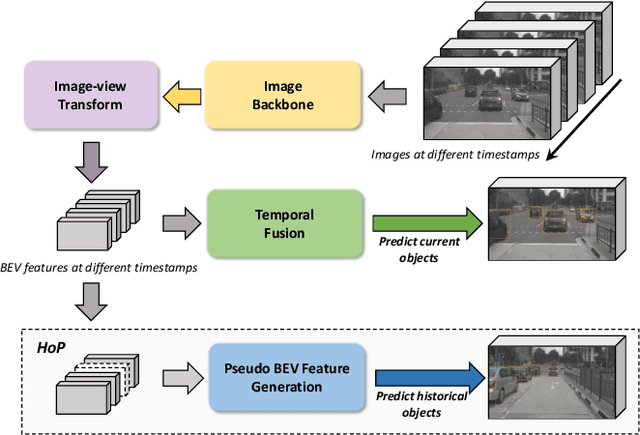

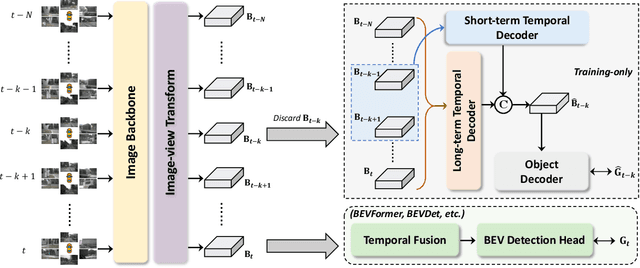

Abstract:In this paper, we propose a new paradigm, named Historical Object Prediction (HoP) for multi-view 3D detection to leverage temporal information more effectively. The HoP approach is straightforward: given the current timestamp t, we generate a pseudo Bird's-Eye View (BEV) feature of timestamp t-k from its adjacent frames and utilize this feature to predict the object set at timestamp t-k. Our approach is motivated by the observation that enforcing the detector to capture both the spatial location and temporal motion of objects occurring at historical timestamps can lead to more accurate BEV feature learning. First, we elaborately design short-term and long-term temporal decoders, which can generate the pseudo BEV feature for timestamp t-k without the involvement of its corresponding camera images. Second, an additional object decoder is flexibly attached to predict the object targets using the generated pseudo BEV feature. Note that we only perform HoP during training, thus the proposed method does not introduce extra overheads during inference. As a plug-and-play approach, HoP can be easily incorporated into state-of-the-art BEV detection frameworks, including BEVFormer and BEVDet series. Furthermore, the auxiliary HoP approach is complementary to prevalent temporal modeling methods, leading to significant performance gains. Extensive experiments are conducted to evaluate the effectiveness of the proposed HoP on the nuScenes dataset. We choose the representative methods, including BEVFormer and BEVDet4D-Depth to evaluate our method. Surprisingly, HoP achieves 68.5% NDS and 62.4% mAP with ViT-L on nuScenes test, outperforming all the 3D object detectors on the leaderboard. Codes will be available at https://github.com/Sense-X/HoP.
Hierarchical Dense Correlation Distillation for Few-Shot Segmentation
Mar 26, 2023Abstract:Few-shot semantic segmentation (FSS) aims to form class-agnostic models segmenting unseen classes with only a handful of annotations. Previous methods limited to the semantic feature and prototype representation suffer from coarse segmentation granularity and train-set overfitting. In this work, we design Hierarchically Decoupled Matching Network (HDMNet) mining pixel-level support correlation based on the transformer architecture. The self-attention modules are used to assist in establishing hierarchical dense features, as a means to accomplish the cascade matching between query and support features. Moreover, we propose a matching module to reduce train-set overfitting and introduce correlation distillation leveraging semantic correspondence from coarse resolution to boost fine-grained segmentation. Our method performs decently in experiments. We achieve $50.0\%$ mIoU on \coco~dataset one-shot setting and $56.0\%$ on five-shot segmentation, respectively.
Two-person Graph Convolutional Network for Skeleton-based Human Interaction Recognition
Aug 12, 2022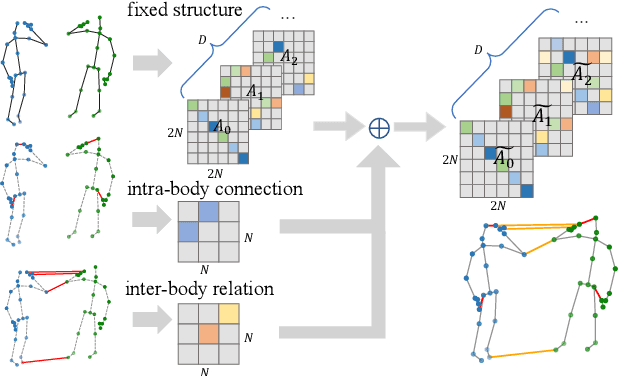
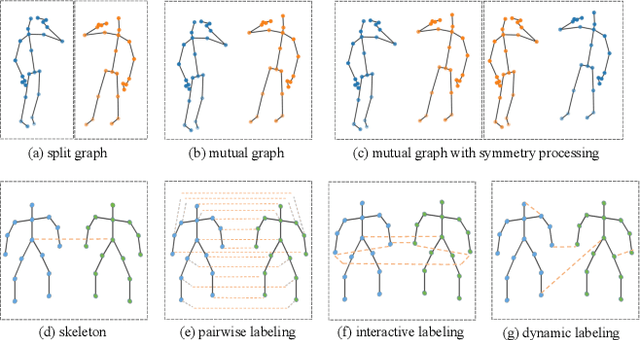
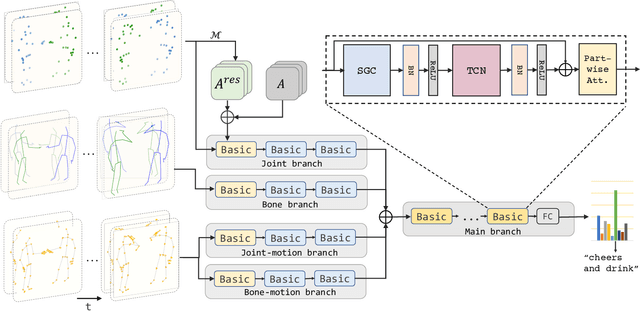
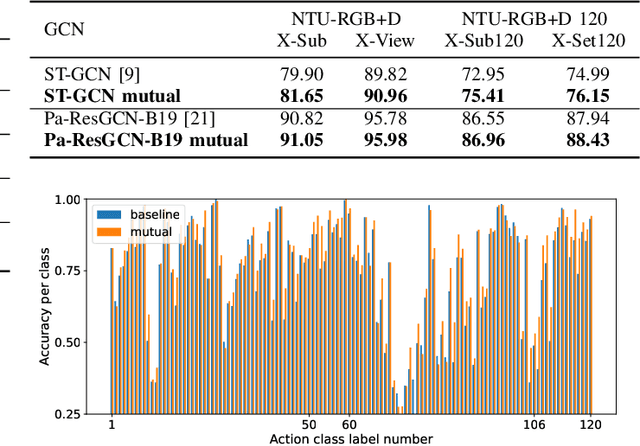
Abstract:Graph Convolutional Network (GCN) outperforms previous methods in the skeleton-based human action recognition area, including human-human interaction recognition task. However, when dealing with interaction sequences, current GCN-based methods simply split the two-person skeleton into two discrete sequences and perform graph convolution separately in the manner of single-person action classification. Such operation ignores rich interactive information and hinders effective spatial relationship modeling for semantic pattern learning. To overcome the above shortcoming, we introduce a novel unified two-person graph representing spatial interaction correlations between joints. Also, a properly designed graph labeling strategy is proposed to let our GCN model learn discriminant spatial-temporal interactive features. Experiments show accuracy improvements in both interactions and individual actions when utilizing the proposed two-person graph topology. Finally, we propose a Two-person Graph Convolutional Network (2P-GCN). The proposed 2P-GCN achieves state-of-the-art results on four benchmarks of three interaction datasets, SBU, NTU-RGB+D, and NTU-RGB+D 120.
 Add to Chrome
Add to Chrome Add to Firefox
Add to Firefox Add to Edge
Add to Edge